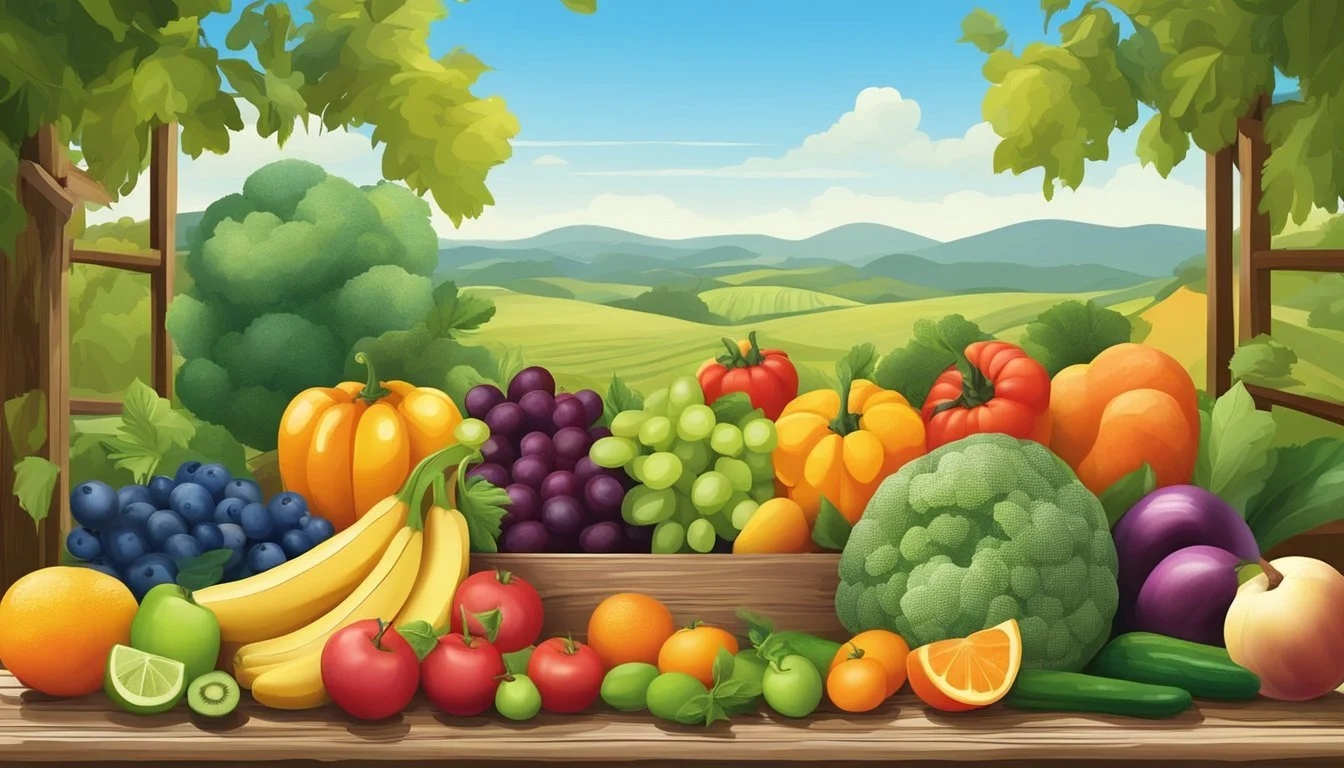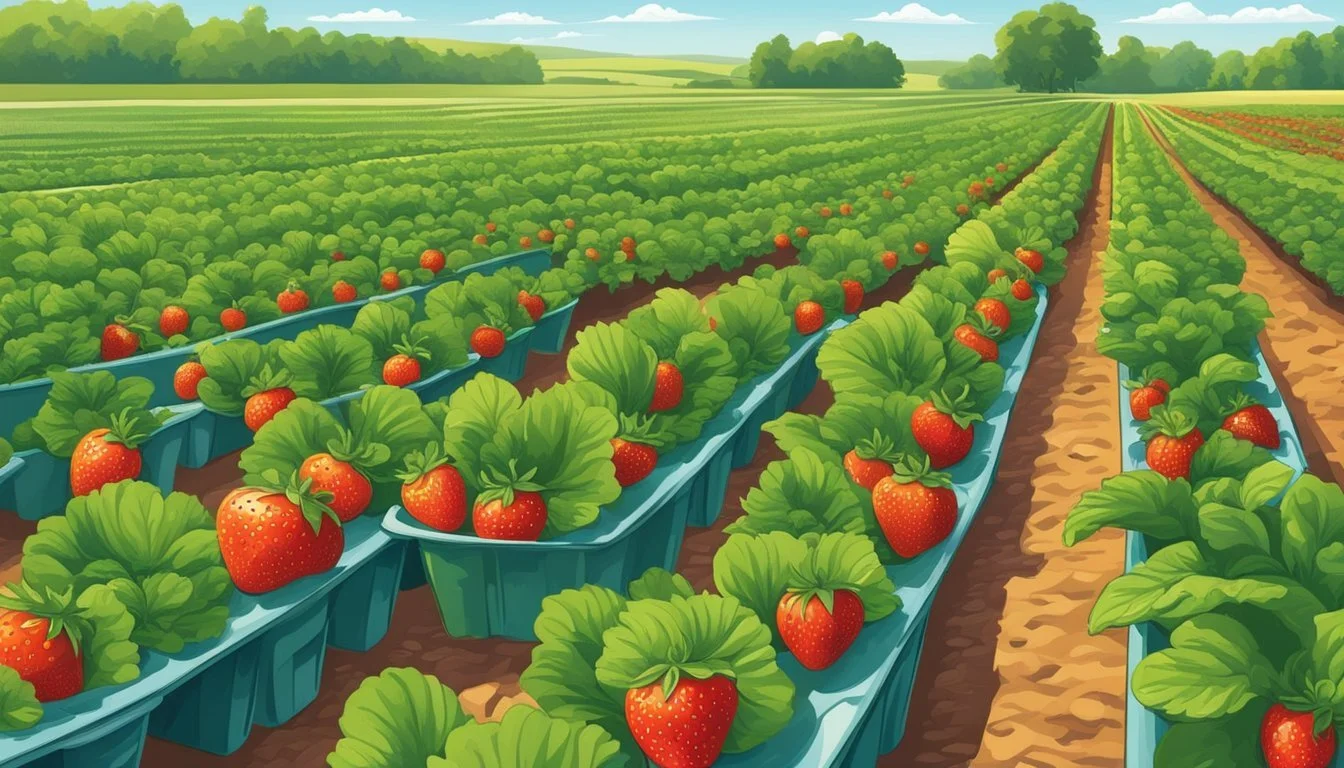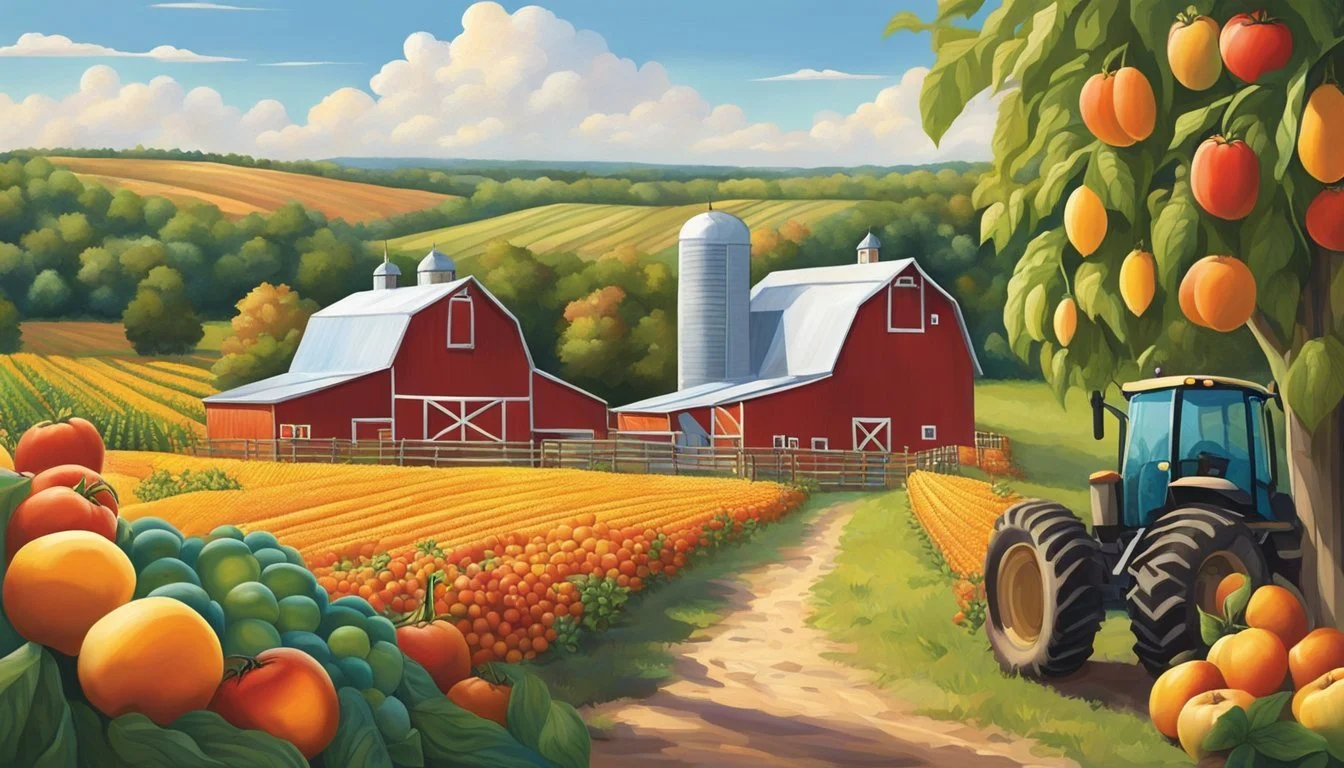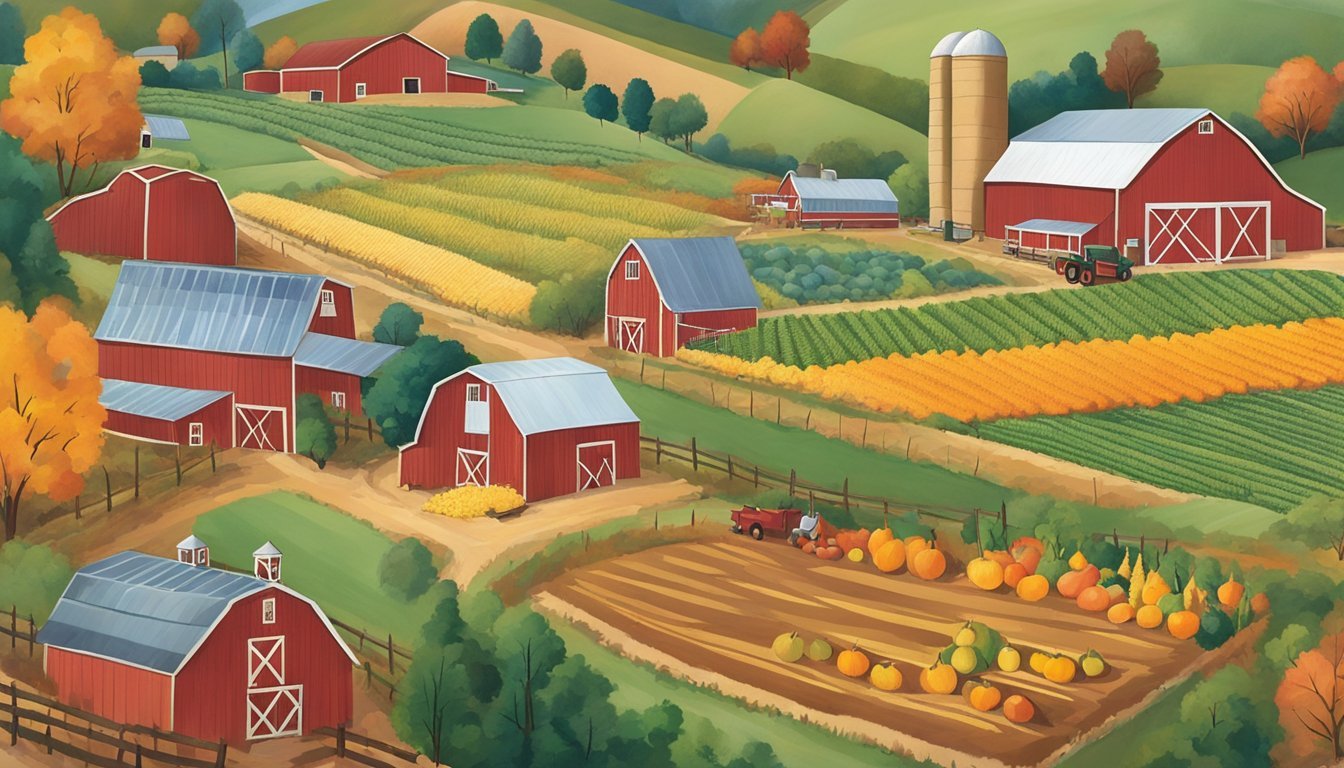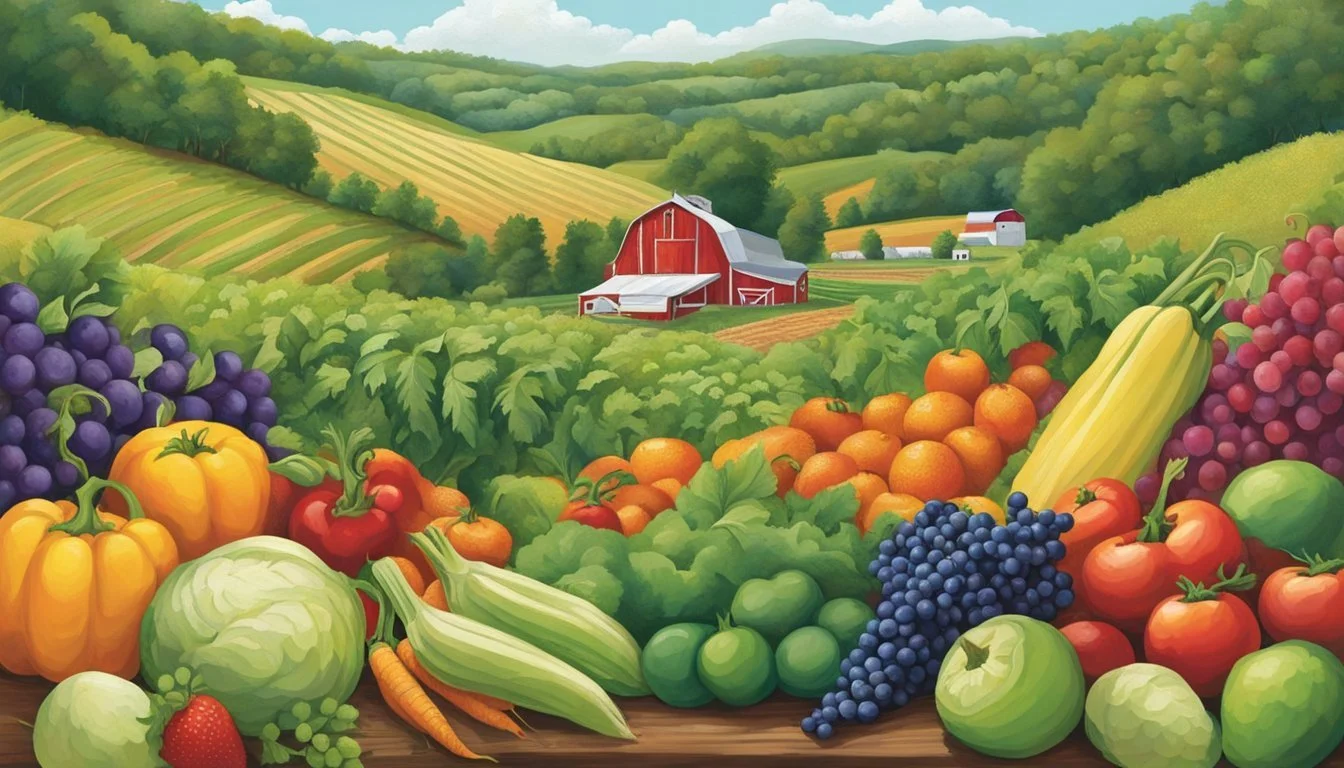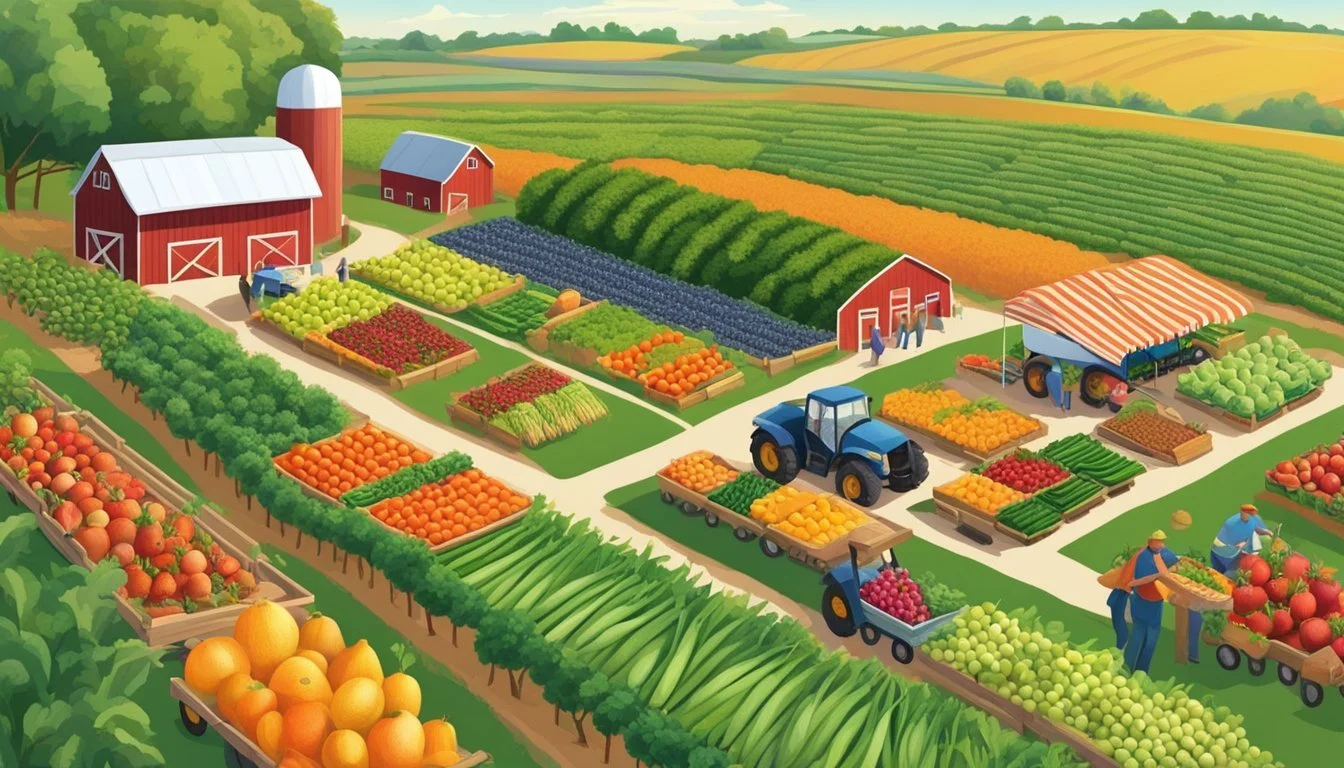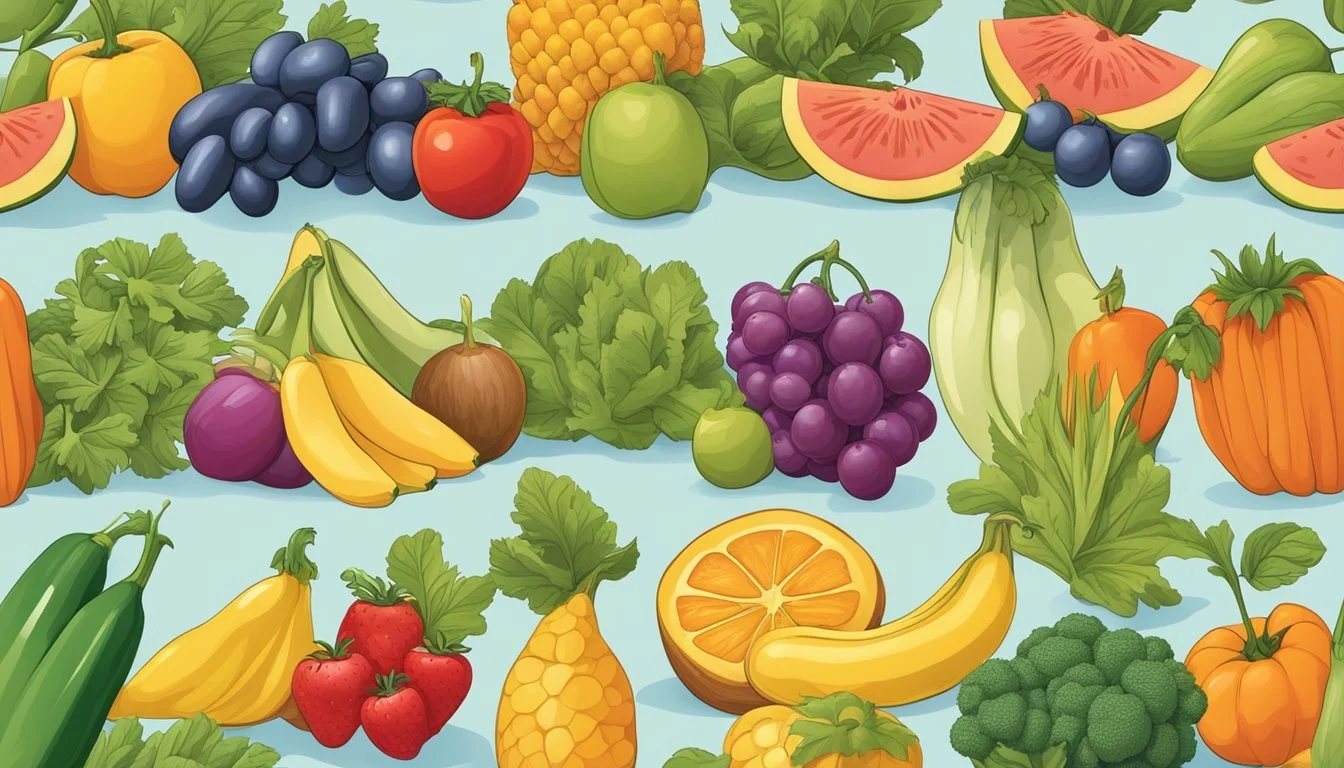Missouri Seasonal Fruit & Veg Guide
Your Quarterly Eating Plan
Missouri offers a rich tapestry of agricultural bounty that changes with the seasons, allowing residents and chefs alike to experience a true farm-to-table dining experience. As each season rolls into the next, the Show-Me State presents an array of fruits and vegetables at their peak flavors. Embracing the seasonal produce not only supports local farmers and the economy, but also ensures that the food is as nutritious and fresh as possible.
Understanding the cycle of produce can enhance one's appreciation and culinary expertise when it comes to preparing seasonal dishes. For instance, juicy strawberries and robust greens mark the arrival of spring, while sweet corn (how long does corn last?) and ripe tomatoes herald the summer months. As autumn's chill sets in, apples and pumpkins become abundant, completing the cycle with the hearty root vegetables of winter. This guide serves as a pathway to navigate through Missouri's seasonal offerings, ensuring that the tables are graced with the freshest ingredients throughout the year.
The benefits of eating seasonal fruits and vegetables in Missouri extend beyond taste and nutrition. It fosters a connection between the consumer and the local environment, promoting a sustainable lifestyle that reduces the carbon footprint associated with long-distance food transportation. Through this guide, individuals are encouraged to explore, cook, and relish the diverse produce that Missouri's fertile grounds cultivate during each season.
What’s in Season in Missouri Right Now?
Missouri's Farm to Table Philosophy
Missouri's commitment to farm-to-table practices reflects a dedication to freshness, quality, and community involvement. Local farmers champion the philosophy that seasonal produce, including a variety of fruits and vegetables, should travel minimal distances from farm to fork.
Seasonal Harvest: They adhere to seasonal cycles, which allows Missouri conditions to naturally dictate the availability of crops. This ensures that diners enjoy fruits and vegetables at their peak flavor and nutritional value.
Quality and Freshness: By focusing on local sourcing, restaurants and consumers receive the highest quality goods. Missouri's fertile land and varying climate contribute to the rich diversity of its produce, enticing a multitude of farm-to-table venues.
Supporting Local: The philosophy extends beyond the plate. It's about stimulating the local economy and forging connections between Missouri farmers and consumers. The relationship fosters trust in the food's origin and the methods of cultivation, prioritizing sustainable and organic farming techniques.
Educational Experience: This movement also serves an educational role, enlightening the community about the importance of seasonal eating and the impact of agriculture on the environment.
The Missouri farm-to-table experience isn't just about dining; it's a comprehensive approach to food that respects the land, supports local economy, and celebrates the season's bounty. The state's varied landscape, from the rolling Ozark hills to the fertile plains, ensures a rich variety of offerings throughout the year, cementing Missouri's identity as a bastion for farm-to-table dining.
Seasonal Guide Overview
In Missouri, the farm-to-table movement emphasizes the importance of consuming produce that is both local and seasonal. The growing season determines which fruits and vegetables are at their peak of freshness and nutrition. A Missouri produce calendar serves as a valuable resource for identifying when various foods are traditionally in season.
Spring heralds the beginning of the growing season; this is when fresh greens, such as lettuce and spinach, start to appear. Asparagus (What wine goes well with asparagus?) too makes an early spring debut, offering crisp, tender spears.
When summer unfolds, Missouri's produce variety reaches its zenith. Ripe, juicy peaches are in full swing from June through October, alongside a medley of berries and melons. Corn and tomatoes are summer staples, typically harvested from mid-June to mid-August, and cucumbers and eggplants join the bounty in July.
As the weather cools and fall makes its entrance, produce such as apples and pumpkins become predominant, along with a continuation of summer crops that extend into the moderate temperatures of early autumn.
Winter is less bountiful, yet some hardy staples like sweet potatoes and winter squash remain available, having been harvested in the fall and storable through the colder months.
Below is a simplified Missouri Seasonal Produce Calendar:
Season Produce Examples Spring Lettuce, Spinach, Asparagus Summer Peaches, Berries, Melons, Corn, Tomatoes Fall Apples, Pumpkins, Sweet Potatoes Winter Winter Squash
Produce selection can be influenced by local growing conditions and weather, so it's recommended to check with local farmers' markets for the most current and accurate information. This guide lays the foundation for making thoughtful choices supporting local agriculture and consuming produce when its flavors are at their peak.
Spring Harvest
Spring in Missouri brings a bounty of fresh produce that starts to flourish after the winter months. The region's climate conditions set the stage for a diverse harvest including berries, stone fruits, and an array of vegetables and herbs, providing plenty of options for gardeners and chefs alike.
Berries
Missouri's spring climate is conducive for growing a variety of berries. Strawberries typically become available in late spring and are among the first fruit to appear in gardens and markets. Gardeners should look for varieties that are disease-resistant to ensure a robust yield. Blackberries (how long do blackberries last?) and raspberries will start to flower, but their fruits will mainly be ripe for picking in early summer.
Stone Fruits
In terms of stone fruits, cherries and apricots may start appearing toward the end of spring. These fruits require well-drained soil and should be monitored for late spring frosts, which can affect their delicate blossoms and subsequent fruit production.
Vegetables & Herbs
A range of vegetables and herbs thrive during Missouri's spring season. Asparagus comes into season, and its spears can be harvested when they reach 6 to 8 inches in height. Gardeners will also find a variety of greens, such as spinach and lettuce, which can be planted early and harvested throughout the season. Herbs such as parsley, cilantro, and chives are hardy choices that can tolerate spring's unpredictable temperatures.
Early Season Techniques
To maximize the spring yield, gardeners should consider techniques like starting seeds indoors and transplanting when the threat of frost has passed. Using row covers can help protect early plantings from unpredictable weather and pests. Proper spacing and timely planting are crucial for disease resistance and optimal plant health.
Spring Recipes
The freshness of spring produce is best highlighted in simple recipes. Strawberries can be used in salads, as toppings for desserts, or simply fresh. Tender asparagus spears are excellent when lightly steamed or grilled. Fresh herbs contribute bursts of flavor in dressings, marinades, and garnishes, embodying the essence of spring in every dish.
Summer Abundance
Missouri's summer months offer a rich variety of fresh produce perfect for farm-to-table dining. With an array of fruits and vegetables reaching their peak, it's an ideal time for harvesting and enjoying the season's bounty.
Peak-Season Fruits
During the summer, Missouri's fruit harvest is in full swing. Peaches, nectarines, and plums become ripe and ready for picking, typically starting in June and lasting through August. Blueberries (how long do blueberries last?), which thrive in the summer warmth, can also be harvested during this season.
Peaches: June to October
Blueberries: July to August
Nectarines & Plums: Mid-summer
Garden Vegetables
Summer gardens in Missouri are abundant with a selection of vegetables. Fresh corn, tomatoes, cucumbers (how long do cucumbers last?), and peppers are commonly grown and reach harvest between June and September. They offer vibrant flavors and are staples for seasonal dishes.
Corn: July through September
Tomatoes & Cucumbers: June through September
Peppers: July through October
Summer Melons
Cantaloupe (how long does cantaloupe last?) and watermelon are summer melons that thrive in Missouri's climate. The warm days and cool nights allow them to develop their full flavor. Both of these melons are typically ready to harvest from August to September.
Cantaloupe: August to September
Watermelon: August to September
Preservation Tips
To extend the enjoyment of summer harvests, preservation is key. Making jam from ripe berries or pickles from cucumbers can keep the flavors of summer alive well into the cooler months. Freezing is another excellent method for fruits like peaches and blueberries.
Jam making: Best with fresh berries
Pickling: Ideal for cucumbers and peppers
Summer Recipes
The abundance of fresh produce during the summer season inspires a multitude of recipes. From peach cobblers to fresh corn salads, the possibilities are endless. Dishes like tomato bruschetta or chilled watermelon soup become summer favorites thanks to their fresh ingredients.
Peach Cobbler: Utilizes fresh peaches
Tomato Bruschetta: Showcases vine-ripened tomatoes
Chilled Watermelon Soup: Highlights the freshness of watermelon
Fall Harvest
Fall in Missouri brings a bounty of produce as the temperatures cool down. This season is characterized by rich flavors and an abundance of hearty fruits and vegetables that make the perfect addition to comfort foods.
Orchard Fruits
In the orchards, the fall crop of apples and pears are ready for harvest. These fruits are a staple in Missouri's autumnal palette.
Apples: Available from late summer through November, varieties such as Honeycrisp, Gala, and Fuji can be found.
Pears: Best collected in late September to mid-October, with Bartlett and Anjou being common.
Root Vegetables & Squashes
Root vegetables and squashes mature into a full-flavored harvest in the fall. They store well, providing a nutritious supply throughout the winter.
Sweet Potatoes: Harvested between September and November, they are versatile for many recipes.
Squash: Varieties like butternut, acorn, and spaghetti are commonly available during this season.
Fall Greens & Brassicas
The cooler temperatures are perfect for growing nutritious greens and brassicas. These crops thrive in the fall conditions.
Kale: This leafy green is rich in nutrients and peaks in flavor after the first frost.
Cauliflower and Broccoli: These vegetables are harvested in the fall for their crisp texture.
Autumn Celebrations
Missouri's fall season is a time for celebration. Farms often feature pumpkin patches, corn mazes, and Christmas tree farms, offering families festive experiences.
Pumpkin Patches: Visitors can pick their pumpkins straight from the field, perfect for carving or cooking.
Corn Mazes: A fun fall tradition, these are typically open from September to October.
Christmas Tree Farms: Toward the end of fall, these farms begin to welcome visitors looking for the perfect tree.
Winter Preparation
Winter in Missouri brings about a shift in farming and market practices, as farmers and consumers turn towards storage crops, indoor growing opportunities, and winter markets for fresh produce.
Storage Crops
Farmers across the state harvest and store a variety of crops that can last well into the winter months. Potatoes, onions, and turnips are prime examples, often kept in cellars or cool storage to maintain freshness. Stored properly, these vegetables can provide a nutritious base for meals throughout the winter.
Common Storage Conditions:
Potatoes: 35-40°F, high humidity
Onions: 30-32°F, moderate humidity
Turnips: 32-38°F, high humidity
Indoor Growing
For fresh produce throughout winter, some Missouri farmers and residents utilize indoor growing systems. This method allows for the cultivation of certain herbs and greens, supplying local markets and tables with fresh flavors. By controlling indoor climates, growers can produce crops regardless of the freezing temperatures outside.
Typical Indoor Crops:
Herbs: basil, parsley, cilantro
Greens: lettuce, spinach, kale
Winter Markets
In addition to storage and indoor growing, winter markets in Missouri remain a hub for seasonal produce and other products. These markets provide an outlet for the sale of winter crops, including fresh-cut Christmas trees and wreaths. They play a crucial role in supporting local agriculture and offer consumers access to fresh products during the colder months.
Winter Market Offerings:
Storage vegetables: potatoes, squash, carrots
Indoor-grown produce: herbs, microgreens
Seasonal items: Christmas trees, wreaths
Attendees at these markets can enjoy local produce well into the winter season, supporting Missouri's vibrant agricultural community.
Regional Variations
Within Missouri, the availability and timing of seasonal produce can vary by region due to differences in climate and growing conditions. Missouri's diverse geography, from the northern plains to the Ozark Plateau, and the river valleys throughout the state, leads to distinct regional growing capabilities.
Northern Missouri typically has a shorter growing season. Here, cold-hardy crops thrive, and certain fruits and vegetables like apples and pumpkins emerge later in the season:
Apples: September - October
Pumpkins: October
Central Missouri, with its moderate climate, supports a variety of produce with a longer season:
Tomatoes: July - September
Sweet Corn: June - August
The Ozark Region often has a milder climate which can extend the growing season of some crops and even permit additional varieties:
Peaches: June - September
Berries: May - July
In urban areas like Kansas City and St. Louis, urban agriculture initiatives can yield fresh produce with different timing due to controlled environments, expanding access to seasonal foods beyond the traditional growing seasons.
Missouri's produce calendar is subject to change yearly, and farmers adapt to these regional variations to supply fresh, local produce to their communities. Consumers seeking specific varieties should check with local farms or farmers' markets for the most accurate and current information on availability.
Selecting Missouri Produce
When selecting produce in Missouri, consumers can anticipate high-quality fruits and vegetables brimming with freshness, especially when sourced in-season. Throughout the state, various varieties of produce become available at different times, ensuring a continuous supply of farm-to-table options.
Peak Harvest Times for Key Produce:
Strawberries and Blueberries: Typically ripen in late spring to early summer.
Tomatoes, Peaches, and Corn: Are summer favorites, with their prime time in June through October.
Apples and Pumpkins: Reach their peak in the fall, indicating the start of festive seasons.
It is helpful for shoppers to know that local Missouri markets often provide the freshest options, as the produce is sold soon after harvest. Consumers are encouraged to support these markets for the freshest produce and to bolster the local economy.
Tips for Ensuring Quality:
Check for firmness and vibrant skin or rind to gauge freshness.
Sniff for a natural and pronounced aroma, which usually signals ripeness.
Inquire with vendors about the practices they use, as many small farms in Missouri are known for organic and humane farming.
Misouri's produce varieties are influenced by the state's diverse climate and soil composition, allowing for a wide cultivation range. When choosing fruits and vegetables, consider these varieties for their robust flavors and contribution to a nutritious meal plan. By selecting Missouri produce, consumers not only enjoy exceptional taste but also support the local agricultural community.
Preparing and Cooking Tips
When preparing Missouri seasonal fruits and vegetables, it's essential to consider methods that best preserve their nutrients and flavor. For most vegetables, such as broccoli and Brussels sprouts (how long do brussels sprouts last?), steaming is recommended to retain both nutrients and texture. Alternatively, roasting these vegetables can enhance their natural sweetness.
Fruits, especially berries like blackberries and blueberries, are best enjoyed fresh to capitalize on their vibrant taste and nutritional benefits. However, they also make excellent additions to recipes like salads, desserts, or jams.
Vegetables:
Broccoli: Steam for 3-5 minutes until bright green.
Brussels Sprouts: Halve and roast with a drizzle of oil at 400ºF for 20-25 minutes.
Cabbage: Shred for slaws or sauté lightly to maintain crispness.
Fruits:
Blackberries: Gently rinse and serve fresh or use in parfaits and pies.
Blueberries: Incorporate into smoothies or bake into muffins without overmixing to prevent bleeding.
When cooking with vegetables and fruits, minimal handling is key. Many recipes benefit from the produce being cut into uniform sizes for even cooking. Incorporating fruits or vegetables into meals not only adds flavor but also increases nutritional content, providing vitamins and antioxidants with each dish.
For the best taste, use produce within a day or two of purchase, and always wash them thoroughly to remove any dirt or residues. Keeping the skin on certain fruits and vegetables can also ensure maximum fiber intake. Always seek out local and seasonal produce to ensure the freshest ingredients for your recipes.
Supporting Local Agriculture
Missouri’s agricultural sector thrives when communities engage in supporting local farms. Consumers can contribute to a vibrant local economy and ensure access to fresh, seasonal produce by choosing Missouri-grown fruits and vegetables. Farm to School (F2S) programs are instrumental in this, as they help procure fresh, local foods for educational settings, fostering an understanding of crop availability and seasonal eating among students.
Missouri farmers offer an array of produce throughout the year, with each season bringing different fruits and vegetables to the forefront. For example, local produce markets may feature succulent peaches between June and October, when they are in peak season. Understanding and adhering to this seasonal availability supports sustainable farming practices and reduces the carbon footprint associated with long-distance food transport.
Below is a list of seasonal fruits and vegetables available in Missouri, which supports local agriculture when purchased in season:
Spring: Asparagus, lettuce, radishes
Summer: Peaches, tomatoes, sweet corn
Fall: Apples, pumpkins, Brussels sprouts
Winter: Winter squash, sweet potatoes, greens
Local agriculture can further be supported through Community Supported Agriculture (CSA) programs, where consumers invest directly in a farm and receive a share of the harvest. These programs create a direct link between Missouri farmers and consumers, enhancing the local economy and ensuring the longevity of sustainable farming practices.
When individuals prioritize buying from local farms, they not only enjoy fresh, nutritious produce but also cultivate a strong community that values the health of its people and its land.
Missouri Produce Calendar
Spring
In the spring, Missourians can enjoy a selection of fresh produce beginning with greens and herbs. By April, strawberries start to appear, followed by radishes, asparagus, and peas.
Greens: March - June
Herbs: March - April
Strawberries: April - June
Radishes: April - June
Asparagus: April - June
Peas: April - June
Summer
Summer ushers in a bounty of fruit and vegetables. One can find the freshest tomatoes, sweet corn, and a variety of berries at their peak. Peaches and cantaloupes are summer staples, providing a sweet treat during the warmest months.
Tomatoes: June - September
Sweet Corn: June - August
Berries: June - August
Peaches: July - August
Cantaloupes: July - August
Fall
The fall harvest presents a new variety, with apples and pumpkins taking center stage. This is an ideal time for root vegetables such as carrots and beets, as well as the late harvest of lettuce and kale.
Apples: September - November
Pumpkins: September - October
Carrots: September - December
Beets: October - December
Lettuce: September - November
Kale: September - December
Winter
Even in winter, some hearty vegetables remain available. Cold-weather crops like spinach and collard greens (how long do collard greens last?) can be harvested, providing fresh green options throughout the colder months.
Spinach: October - November
Collard Greens: November - December
The Missouri produce calendar serves as a guide for consumers looking for the freshest seasonal fruits and vegetables, and a reminder of the state's diverse agricultural offerings throughout the year.
Conclusion
Seasonality deeply influences Missouri's produce offerings, and embracing this cycle promises fresher, more flavorful, and often more nutritious fruits and vegetables. Farm-to-table practices not just enrich the dining experience but also bolster the state's agricultural economy.
Missouri's diverse agriculture allows it to produce a myriad of fruits and vegetables, corresponding neatly with the seasons. Summer and fall months overflow with juicy peaches and tomatoes, while spring invites a flourish of leafy greens and radishes.
Here's a succinct overview of what one may typically find on a Missouri farm-to-table:
Spring: Asparagus, Leafy Greens, Radishes
Summer: Peaches, Tomatoes, Berries, Corn
Fall: Apples, Squashes, Root Vegetables
Winter: Offers less variety but hardy produce like winter squash and stored apples.
These cycles not only dictate the freshness and availability but also allow consumers to anticipate what's coming next. For those within Missouri, a conscious choice to adhere to these cycles means supporting local farmers and contributing to a more sustainable food system.
It is in the interest of restaurateurs, home cooks, and consumers to recognize and respect these seasonal patterns. This not just ensures a superior culinary experience but also aligns with environmentally friendly practices, as it reduces the need for long-distance transport and associated carbon emissions.
Ultimately, Missouri's farm-to-table offerings reflect a commitment to quality and community. By aligning food choices with the state's seasonal rhythms, the benefits are manifold – culminating in an enriched local economy, a healthier environment, and a deeply satisfying culinary culture.



